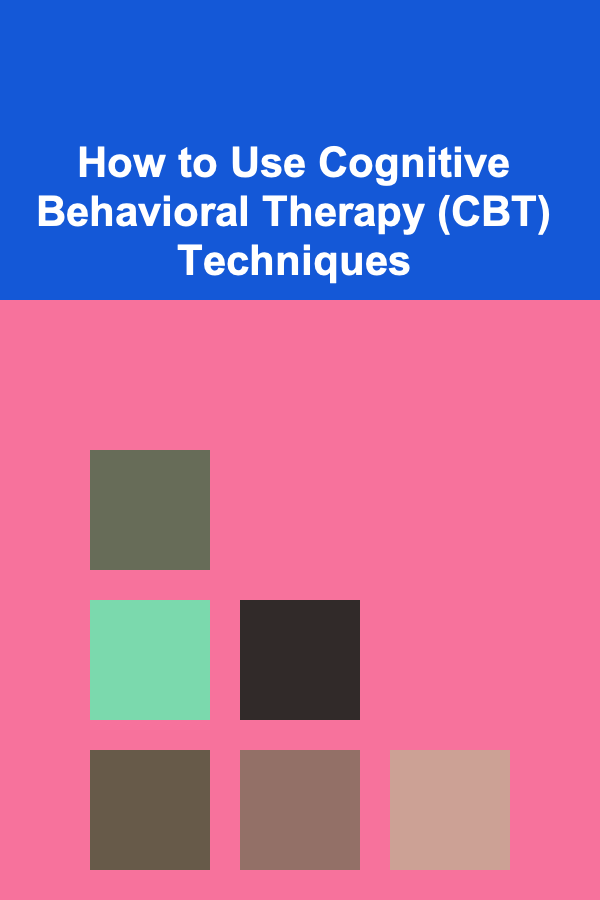
How to Use Cognitive Behavioral Therapy (CBT) Techniques
ebook include PDF & Audio bundle (Micro Guide)
$12.99$11.99
Limited Time Offer! Order within the next:

Cognitive Behavioral Therapy (CBT) is one of the most widely recognized and effective therapeutic approaches for treating a variety of mental health disorders, including anxiety, depression, and obsessive-compulsive disorder (OCD). Rooted in the idea that our thoughts, feelings, and behaviors are interconnected, CBT helps individuals challenge and change negative thought patterns and behaviors that contribute to emotional distress. In this article, we will explore how to use CBT techniques in daily life, whether you're seeking to improve your mental well-being or working through specific challenges.
Understanding Cognitive Behavioral Therapy
CBT is a structured, time-limited, and goal-oriented therapy that was first developed in the 1960s by Dr. Aaron Beck. It operates on the principle that our thoughts influence our emotions, which in turn affect our behaviors. The central idea of CBT is that by identifying and challenging distorted or unhelpful thought patterns, individuals can alter their emotional responses and behaviors. CBT is typically short-term, making it an accessible option for those seeking practical tools for managing mental health concerns.
The key elements of CBT include:
- Cognitive Restructuring: Identifying and challenging irrational or negative thoughts (also known as cognitive distortions) and replacing them with more realistic and balanced thoughts.
- Behavioral Activation: Engaging in activities that promote positive emotions and reduce negative behaviors, particularly for those suffering from depression.
- Exposure Therapy: Gradually confronting feared situations or stimuli in a controlled manner to reduce anxiety and avoidance behaviors.
In practice, CBT involves working collaboratively with a therapist to develop skills and strategies for managing emotional and psychological challenges. While therapy sessions are typically the setting for CBT techniques, many of these techniques can be applied independently as self-help tools to improve mental health and well-being.
Common CBT Techniques and How to Use Them
1. Cognitive Restructuring and Reframing
Cognitive restructuring is one of the core techniques of CBT. It involves identifying irrational or distorted thought patterns and replacing them with healthier, more balanced thoughts. This technique is especially helpful for managing negative self-talk, which can contribute to feelings of anxiety, depression, and self-doubt.
Steps to Practice Cognitive Restructuring:
-
Identify Negative Thoughts: Start by noticing the negative thoughts that arise in response to situations. For example, you might have a thought like, "I'm going to fail this exam," or "Nobody likes me."
-
Challenge the Thought: Ask yourself if the thought is based on facts or if it is a distortion of reality. Common cognitive distortions include:
- Catastrophizing: Assuming the worst-case scenario.
- Overgeneralization: Making broad conclusions based on a single event.
- Personalization: Blaming yourself for events outside of your control.
- Mind reading: Assuming you know what others are thinking.
-
Replace with Balanced Thoughts: After challenging the negative thought, come up with a more balanced and realistic alternative. For example, instead of thinking, "I'm going to fail this exam," you might reframe it to, "I may be nervous about the exam, but I've studied, and I can do my best."
-
Practice: This process takes time. Regular practice of cognitive restructuring can help retrain your brain to think in a more positive, constructive manner.
2. Behavioral Activation
Behavioral activation is a technique often used in CBT to help individuals with depression engage in activities that improve mood and reduce feelings of hopelessness. It focuses on the idea that inactivity and withdrawal from pleasurable activities contribute to depressive symptoms, creating a vicious cycle.
Steps to Practice Behavioral Activation:
- Identify Activities That Bring Pleasure or Purpose: Think about activities you used to enjoy or activities that might help you feel accomplished. These could be anything from exercise to creative hobbies or spending time with loved ones.
- Create a Schedule: Plan and schedule time to engage in these activities. Even if you don't feel like doing them initially, the goal is to break the pattern of avoidance and inactivity.
- Start Small: Begin with simple, manageable tasks that don't feel overwhelming. Even a small achievement can provide a sense of satisfaction and progress.
- Track Your Progress: Keep a journal to track the activities you've completed and your mood afterward. This helps reinforce the connection between action and emotional improvement.
- Gradual Increase: As you get used to engaging in more activities, increase the complexity or number of tasks. This helps build momentum and creates a sense of accomplishment.
3. Mindfulness and Relaxation Techniques
Mindfulness is the practice of staying present and fully engaged in the current moment, free from judgment. In CBT, mindfulness techniques can be used to help individuals manage anxiety, stress, and intrusive thoughts. It encourages individuals to observe their thoughts and feelings without getting caught up in them, leading to improved emotional regulation and self-awareness.
Steps to Practice Mindfulness:
- Observe Your Thoughts: Take a moment to notice the thoughts in your mind. Try not to judge them as good or bad, just observe them as they are.
- Focus on Your Senses: Engage your senses by focusing on what you can see, hear, smell, taste, or feel. This can help you stay grounded in the present moment and reduce anxiety about the future or past.
- Breathing Exercises: Deep breathing is an effective way to manage stress and anxiety. Try the "4-7-8" technique: Inhale through your nose for 4 counts, hold your breath for 7 counts, and exhale slowly through your mouth for 8 counts.
- Body Scan: Perform a body scan by focusing on different parts of your body, noticing any tension or discomfort. This practice helps promote relaxation and awareness of physical sensations.
4. Exposure Therapy
Exposure therapy is a technique used to help individuals confront and gradually reduce fear and anxiety. This technique is based on the principle that avoiding feared situations only reinforces anxiety. Exposure therapy involves exposing yourself to feared situations in a controlled and systematic manner, allowing your anxiety to decrease over time.
Steps to Practice Exposure Therapy:
- Identify Your Fears: Write down the situations, objects, or thoughts that cause you anxiety. These could range from public speaking to social interactions or even specific phobias like spiders or heights.
- Rank Your Fears: Rate the intensity of your anxiety for each fear on a scale of 1 to 10. This helps you prioritize which fears to address first.
- Start Small: Begin by exposing yourself to the least anxiety-provoking situation on your list. For example, if you're afraid of public speaking, start by speaking in front of a mirror or with a trusted friend.
- Gradual Exposure: Over time, gradually increase the intensity of the exposure. Continue to practice until the fear becomes more manageable. This step-by-step approach allows you to build confidence and reduce anxiety in a controlled environment.
5. Journaling and Thought Records
Journaling is a useful technique in CBT for tracking thoughts, feelings, and behaviors over time. By keeping a thought record, individuals can identify patterns in their thinking and gain insights into how certain thoughts impact their emotional state.
Steps to Practice Journaling:
- Write Down Your Thoughts: Record any negative or distressing thoughts that arise throughout the day. Try to be as specific as possible about the situation, the thoughts you had, and your emotional response.
- Identify Cognitive Distortions: Review your thoughts and identify any cognitive distortions, such as catastrophizing or overgeneralization. This helps you become more aware of patterns in your thinking.
- Challenge and Reframe: Once you've identified distortions, challenge the validity of those thoughts and replace them with more balanced alternatives.
- Track Your Progress: Review your thought records periodically to see how your thoughts and behaviors evolve over time. This allows you to track your progress and celebrate small victories.
6. Problem-Solving and Goal Setting
Another important aspect of CBT is helping individuals develop practical problem-solving skills. When faced with challenges, many individuals may become overwhelmed or feel stuck. CBT teaches effective strategies for breaking down problems and setting achievable goals.
Steps to Practice Problem-Solving:
- Identify the Problem: Clearly define the issue you're facing. Break down larger problems into smaller, manageable parts to make them less overwhelming.
- Generate Solutions: Brainstorm possible solutions and weigh the pros and cons of each option. This helps you feel more in control and confident in your ability to address challenges.
- Set Goals: Break down your solutions into smaller, actionable goals. Make sure they are specific, measurable, achievable, relevant, and time-bound (SMART goals).
- Evaluate and Adjust: Monitor your progress toward your goals and adjust your approach if needed. Celebrate your successes along the way, no matter how small they may seem.
Conclusion
Cognitive Behavioral Therapy (CBT) offers a practical and effective way to manage mental health challenges by changing negative thought patterns and behaviors. By using techniques like cognitive restructuring, behavioral activation, mindfulness, and exposure therapy, individuals can develop healthier habits and improve their emotional well-being. While CBT is typically conducted with a therapist, many of these techniques can be used independently to enhance self-awareness, reduce stress, and promote personal growth.
Whether you're dealing with anxiety, depression, or simply looking to improve your mental resilience, incorporating CBT techniques into your daily life can be a transformative experience. The key to success with CBT is consistent practice and an openness to challenging your thought patterns. Over time, you will find that you're able to manage difficult emotions more effectively and make lasting, positive changes in your life.
Reading More From Our Other Websites
- [Home Space Saving 101] How to Implement Room Ideas to Save Space Effectively
- [Survival Kit 101] The Best Eco‑Conscious Survival Kit
- [Weaving Tip 101] Beginner to Master: A Creative Journey Through Modern Weaving Techniques
- [Personal Care Tips 101] How to Achieve a Glowing Complexion Through Personal Care
- [Organization Tip 101] How to Choose the Perfect Accent Wall for Your Room
- [Beachcombing Tip 101] How to Create a Stunning Collage from Mixed Media Beachcombing Materials
- [Organization Tip 101] How to Use Shelving Units to Enhance Bathroom Storage
- [Home Maintenance 101] How to Repair Common Wear and Tear in Your Home
- [Organization Tip 101] How to Organize Your Music Room for Band Rehearsals
- [Home Budget 101] How to Budget for Unexpected Expenses: Building an Emergency Fund for Peace of Mind

How to Categorize Recipes by Dietary Restrictions
Read More
How to Create a Music Mood Board for Inspiration
Read More
How to Decorate Your Walls on a Budget
Read More
How to Improve Your Tennis Serve with Minimal Effort
Read More
How to Turn Your Artwork into a Unique Matching Game
Read More
10 Tips for Mastering Volleyball Serve Receive
Read MoreOther Products

How to Categorize Recipes by Dietary Restrictions
Read More
How to Create a Music Mood Board for Inspiration
Read More
How to Decorate Your Walls on a Budget
Read More
How to Improve Your Tennis Serve with Minimal Effort
Read More
How to Turn Your Artwork into a Unique Matching Game
Read More